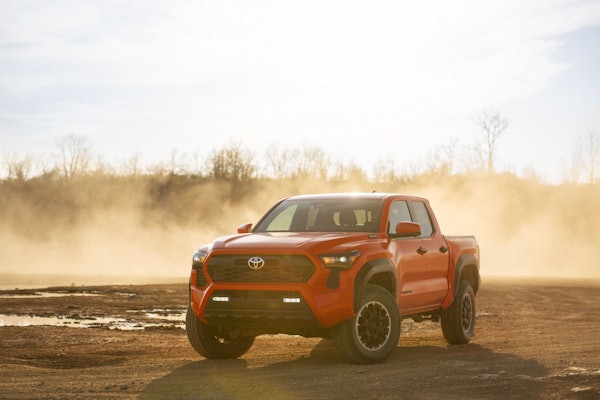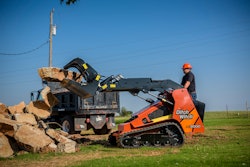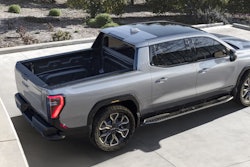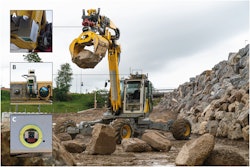

Quality and endurance is one factor, but the economics of a process seal the deal for contractors. With WMA, less time is needed for production, compaction is easier and faster and the mix can be hauled longer distances.
WMA is heated to a lower temperature, so less fuel is needed—on the order of 20 percent or more—and it is heated faster as a result. It’s more dense and can be worked and compacted easier than hot-mix asphalt (HMA) and hauling time and distance is extended because WMA cools slower than HMA.
Eastern North Dakota’s Cass County, with the largest population in the state and one of the largest in terms of highway miles, provides a good case study in using WMA and RAP in combination. In 2012, contractors for the county completed an 8-mile stretch of County Road 26 using the mix. By doing so, they were able to come in under the original bid by nearly 14 percent.
Andrew Wrucke, currently an associate research fellow at the North Dakota State University’s Upper Great Plains Transportation Institute, was working as a design and construction engineer for the Cass County Highway Department at the time of the project. The contractor, Knife River Materials, told him if the county allowed them to use warm mix, they would match the project’s original bid price.
“The contractor also suggested we use RAP within that, because they found warm mix and RAP tend to work well together,” he said. “And it would give us an additional costs savings. We crunched the numbers and found it would save about $200,000.”
The RAP for the mix came from milling 1 inch off the roadbed. That milling work offered an additional benefit of providing a smoother work surface before paving even started.
“By milling the surface first you get rid of those irregularities,” Cass County Highway Department Engineer Jason Benson says. “It’s eliminated our need to put a 10 percent buffer into our mix quantity to fill those irregularities. By milling it, we had less than 5 percent because we started off with a nice milled surface. Then we had the millings left over to add as RAP.”
WMA’s slow-cooling nature was appealing to Benson as well, due to North Dakota’s open expanse and distances. “It’s not uncommon for a 45-mile truck haul, so a lot of times that asphalt is going to sit in the truck for an hour,” he says.
This benefit was directly tested against HMA on a day the county had simultaneous projects, one using HMA and one using WMA in temperatures above 90 degrees, Benson says. The HMA road was still soft after being rolled out, while the WMA road was cooling down and setting up, which allowed traffic to travel sooner.
“On the HMA road we had to keep the flagger a couple of miles back to make sure vehicles weren’t stopped and waiting for the pilot car on that tender hot mix,” he adds.
RAP ratios
When RAP enters the mix conversation, it becomes all about percentages. Mixes with up to 40 percent RAP have been used for the past few years with quality results, as indicated by recent winners of the National Asphalt Pavement Association’s Quality in Construction Awards.
But while high-RAP mixes have worked well, 20 percent is the going rate state departments of transportation and county highway engineers are using in their specifications, and it’s the percentage the North Dakota Department of Transportation (NDDOT) and Cass County use in their specifications.
“Since the CR 26 project we’ve pretty much bid all of our projects at a 20 percent RAP,” Benson says. “A couple of year’s ago we were at 20 percent plus or minus 5 percent, but that had to change to 15 percent plus or minus 5 percent after requirements for a federal aid project we did that used RAP, since that was the maximum allowed.”
After investigating the situation, Cass County settled on 20 percent RAP in their new specification. “And talking with the contractors around here, it didn’t seem to be an issue,” Benson says.
Integrating RAP with WMA becomes a lesson in mix design, particularly when applying thinlays. Chuck Fuller, president of J.D. Ramming Paving in Austin, Texas, has been able to use 40 percent RAP in warm mixes for thinlay work for limited residential projects, as the Texas Department of Transportation doesn’t allow RAP in thinlay mixes for their projects.
“We modify the mix and use a warm mix additive,” Fuller says, “which helps maintain the temperature. For one project in a subdivision, we were able to lay a 40 percent RAP mix for about the same cost as a two-course chip seal. It’s in its fifth or sixth season, and it’s going to last another four to five years.”
In addition to additives, the emulsions created by foaming equipment at the plant helps with coating RAP and provides a better mixture with the old oil and new oil, Wrucke adds. “With that foamer you’re basically forcing an emulsification that’s in the process, and when the water breaks off that’s when you get the cooler temperatures too.”
Continued use
For Benson, the performance of the County Road 26 speaks volumes for the quality of WMA and RAP mixes.
“We haven’t noticed any issues with cracking,” he says. “Typically we end up having a lot of thermal cracking in roads the next spring after construction following our cold winters. With either the warm mix or the RAP we haven’t seen it get more brittle or have more cracking.”
After the success of this project, Benson and Wrucke presented the details of their experience with WMA and RAP at multiple conferences and passed on their specifications and plans with fellow county engineers and road superintendents.
“We’re at the point now where if the low bid came in with warm mix, we would definitely take it over a higher-priced hot mix,” he continues. “We’re going to continue to leave that as an option with our contracts — bid it with RAP and the option to use either hot mix or warm mix.”





![eshima-ohashi-bridge-10[2]](https://img.equipmentworld.com/files/base/randallreilly/all/image/2015/11/eqw.eshima-ohashi-bridge-102.png?auto=format%2Ccompress&fit=crop&h=167&q=70&w=250)






